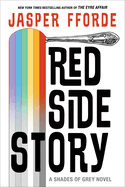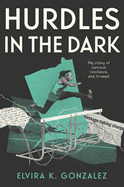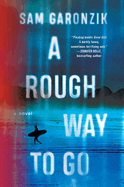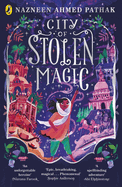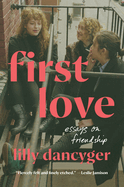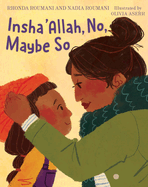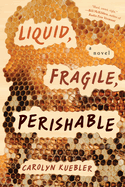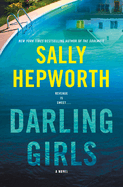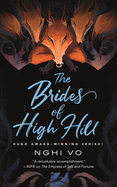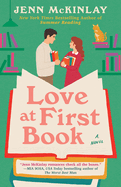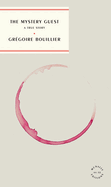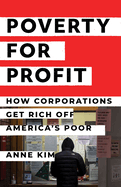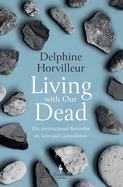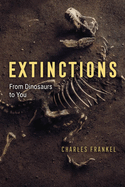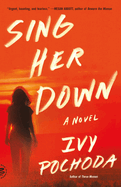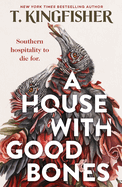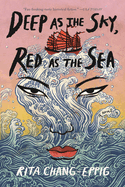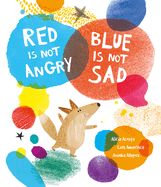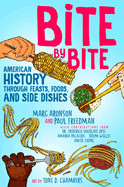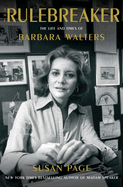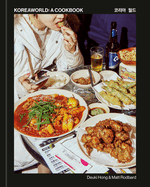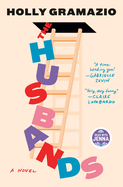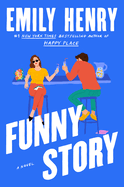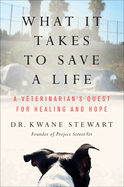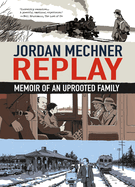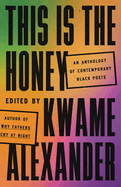Friday, May 31, 2024
This week's recommended reading includes Red Side Story, a witty and intriguing installment in Jasper Fforde's series about a satirical dystopia in which "status is determined based on the colors a person can see"; and The Year of Living Constitutionally, in which humorist A.J. Jacobs takes a "distinctively irreverent" approach to understanding what he calls the country's "most influential and perplexing" foundational document. Plus, Hurdles in the Dark: My Story of Survival, Resilience and Triumph by Elvira K. Gonzalez is an "inspiring young adult memoir that details the life of a Mexican American athlete fighting to get a track scholarship."
In The Writer's Life, novelist Eve J. Chung praises the abundance of books that have impacted her, as well as the importance of her local library, where she finds "a sense of permanence."
Red Side Story
by Jasper Fforde
Wit and intrigue abound in Red Side Story, the long-awaited second book in the satirical dystopian Shades of Grey series by Jasper Fforde (The Constant Rabbit; Early Riser).
Eddie Russett could have great expectations if not for the fact that he's about to be tried for murder. In the society that developed during the five centuries that followed the little understood "Something That Happened," status is determined based on the colors a person can see. Eddie can see a high enough percentage of red to be an attractive marriage prospect and to possibly become the Red Prefect someday. Unfortunately, he is likely to be found guilty and sentenced to death by color exposure in the Green Room. He's also having an illegal opposite-color affair with Jane Brunswick, a low-level green.
Fforde swiftly brings readers up to speed on the series' conceit and previous events, so those who have not read Shades of Grey (or who read it when it was published in 2009) will not be lost. His trademark absurdity and dry wit is on full display as Eddie, Jane, and a shifting collection of allies attempt to discover what secrets have been hidden by the Rules and escape almost certain execution. Fans of Fforde's Thursday Next series will particularly enjoy the literary humor during a performance of Romeo and Juliet that has been heavily revised to reinforce this society's principles. As Eddie and Jane unearth dramatic revelations, readers will be eager to see where their adventures take them next. --Kristen Allen-Vogel, information services librarian at Dayton Metro Library
Discover: A society based on vision makes for a deeply funny dystopia in the long-awaited second book of Jasper Fforde's Shades of Grey series.
Liquid, Fragile, Perishable
by Carolyn Kuebler
In Liquid, Fragile, Perishable the townspeople of tiny Glenville, Vt., share both optimism and loss as Carolyn Kuebler's debut novel weaves an intricate interplay among a close-knit population and the natural world that shapes their fate.
Cautiously hopeful residents savor "the first real day of sun" in May, in individual passages of interior monologues. Written in crisp, concise thoughts, the novel unfolds with a distinctive step-by-step tone of inevitability. While characters have agency, they are also vulnerable to the choices of their neighbors and the undeniable effects of climate change. "The bees are losing their way" and the ski slope traffic suffers from lack of snow. Except for the Calpers, outsiders from New York who've built a new home on the ridge, relationships and family histories are well established. A fateful shift begins when lifelong friends and high school students Sophie, Amber, and Honey include Will Calper, the teenage son of the newcomers, in their social circle. Sophie "imagines that one day it will be different, grander somehow, but she has no idea how quickly everything can change and how little control she will have." Remote Glenville is not immune from substance abuse, poverty, and other social ills, and even the mostly troublesome LeBeau clan evokes some sympathy. Kuebler sets her novel over one year, and the changes of the seasons reflect the town's human dramas. As the novel closes in spring, the sun "shines on the surface of the river now, breaking into patterns of darkness and light." --Cheryl McKeon, Book House of Stuyvesant Plaza, Albany, N.Y.
Discover: A small Vermont town is a microcosm of life's joys and sorrows, and residents increasingly see the effects of climate change on their lives in this debut novel.
A Good Life
by Virginie Grimaldi, transl. by Hildegarde Serle
In A Good Life, French author Virginie Grimaldi delivers a sensitive, familial love story about the unrivaled, transformative bond of sisterhood. The novel is set in the beautiful Basque countryside, where the adult Delorme sisters, Emma and Agathe, are reunited after a five-year estrangement. The two are forced to come together to spend one last summer vacation at the home of their beloved--now deceased--grandmother, Mima. The seaside dwelling, about to be sold, holds dear memories that have anchored the sisters throughout their lives, despite their differences.
During the week shared at Mima's house for the last time, the Delorme sisters relive and revisit bygone stories. Short, evocative chapters render slice-of-life remembrances that take readers through episodes that defined and shaped the women's childhoods and teenage years--and probe stories of family and other loves and losses sustained into adulthood. These enlightening scenes are contrasted against their lives in the present. They come to discover how Mima and the "good times" they shared via her influence at the Basque house every summer served to calm and steady them through the storms of life. The deep challenges that befall the family mark the women's identities, personalities, and coping methods. Tensions build in the narrative as Emma and Agathe ultimately confront each other and tend to the wounds that drove them apart.
Grimaldi's concise prose, translated by Hildegarde Serle, is striking and vivid, painting a sympathetic portrait of the enduring bond of sisterhood. Readers will fall under the spell of a compassionately revealed story that blends poignancy and humor in depicting the transcendental nature of familial love and forgiveness. --Kathleen Gerard, blogger at Reading Between the Lines
Discover: An evocative, powerful love story about two adult sisters forced to reconcile their lives at their grandmother's seaside home in the Basque Country.
Mystery & Thriller
A Rough Way to Go
by Sam Garonzik
Surfing, high finance, a stay-at-home dad--the seemingly unrelated main ingredients of A Rough Way to Go, Sam Garonzik's debut, have likely never before been combined in a thriller. But even if they have been, it's impossible to imagine that another writer could have cooked up something so fiendishly clever with them.
Narrator Pete Greene is the at-home parent for his and his breadwinner wife's toddler, Luke. They live in a beach town outside New York City; Pete surfs to interrupt the tedium of parenting. One day, news gets around that a male body in a wetsuit has washed up on the beach; the surfboard leash tied to his ankle has snapped. When the papers report the story--the dead man is finance bigwig Robert Townsend--Pete realizes that he knew the guy: on the day Townsend went missing, he and Pete had spoken on the beach and agreed that the waves were crap. So why would Townsend have gone surfing that day? Pete isn't buying the surfing-accident angle. He gets nowhere with the police, so he decides to play detective, sometimes while exhibiting creative morality, often with "my assistant" (Luke) in tow.
At first Garonzik seems to be going for an underdog's-revenge story, but he pursues something trickier. Readers should stay on high alert: even scenes that seem diversionary have a way of ultimately fortifying the plot, which concludes blindsidingly. A Rough Way to Go should be shelved with the darkest noir, its surfer-bro everyman surely crime fiction's first. --Nell Beram, author and freelance writer
Discover: Surfing, high finance, a stay-at-home dad--the seemingly unrelated main ingredients of this debut thriller are cooked up into something fiendishly clever.
Darling Girls
by Sally Hepworth
Some families are not connected by blood but forged by love, concern, and trauma, as in the case of the three Australian women in Sally Hepworth's emotionally gripping Darling Girls.
Jessica Lovat, Norah Anderson, and Alicia Connelly became sisters when they were placed as children in the Wild Meadows Farm foster home under Holly Fairchild's watch. "Miss Fairchild," as the girls called her, initially seemed loving and kind, especially to Jessica, the first to arrive. But Fairchild's anger and abusive nature soon erupted. Each girl learned that the slightest disobedience, display of friendship amongst themselves, or even laughter could result in Fairchild forcing them to go hungry or locking them in the basement. More than 25 years have passed since the three left foster care. While they have all reinvented themselves, Jessica, Norah, and Alicia still harbor emotional scars that become more prominent when the police contact them. Human bones have been found under Wild Meadows' razed farmhouse. Now, the sisters must travel from Melbourne back to Port Agatha and dredge up their childhood memories as the police investigate who the bones belong to.
Hepworth's (The Good Sister; The Mother-in-Law) tightly coiled plot exposes problems in Australia's foster care system, exacerbated by overworked social workers and a lack of oversight. Darling Girls (which is also Fairchild's affectionate and contemptuous nickname for the trio) flawlessly illustrates each girl's backstory, how they entered foster care, and how vulnerable they were to the system's failings, showing how their pasts shaped the adults they became. A stunningly clever twist elevates the intense plot. --Oline H. Cogdill, freelance reviewer
Discover: In this intense and tightly coiled thriller, three women return to the site of the abusive foster home where they grew up when human bones are found beneath it.
Disturbing the Dead
by Kelley Armstrong
The ethics of unwrapping a mummy quickly become a secondary concern to murder for detective Mallory Atkinson and Dr. Duncan Gray in Disturbing the Dead, the atmospheric and intricately plotted third novel in the Rip Through Time series by Kelley Armstrong (A Stranger in Town, The Boy Who Cried Bear).
Mallory is settling into Victorian-era Scotland, where she was mysteriously transported back 150 years into the body of Catriona Mitchell, housemaid to Duncan and his widowed sister Ilsa. Mallory worries about her family in the 21st century, but she has become attached to her employers. They're aware that she's a homicide detective from the future, and she has begun to assist Duncan when his job as an undertaker leads him to consult with the police as a medical examiner. When they're invited to attend the unwrapping of a mummy, the two are asked to perform the honors in the absence of the host--but the corpse inside is fresher than they expected.
Armstrong has created a detailed and approachable historical series with a time-travel twist. Mallory's world is full of characters that are less commonly centered in 19th-century-set fiction, including the biracial Duncan, the chemist Ilsa, and the streetwise Jack, whose true gender is known only to a trusted few. The first hints of modern forensic science are also appearing, though they've yet to be widely accepted, making the period fertile for detective fiction. Readers will be pleased at what developments on the time-travel front suggest for the future of the series. --Kristen Allen-Vogel, information services librarian at Dayton Metro Library
Discover: Intriguing characters and a knack for historical detail anchor Disturbing the Dead, an engrossing Victorian mystery.
Science Fiction & Fantasy
The Brides of High Hill
by Nghi Vo
Nothing is as it seems as nonbinary Cleric Chih travels with a noble family to an eerie estate in The Brides of High Hill, a tightly plotted gothic fantasy novella from Nghi Vo (The Empress of Salt and Fortune, Siren Queen). The Phams are only too happy to trade their daughter, Nhung, for the stability and prestige that a marriage to Lord Guo promises, but when they arrive at Doi Cao, Chih and the young bride in their care find its buildings and people in a state of neglect--and worse. Concerned by rumors and the predatory age gap between bride and groom, Chih begins to investigate.
As Chih guides Nhung through introductions and wedding negotiations, their sense that something is horribly wrong intensifies. What are the figurines spread around the estate grounds, and why do they smell so terrible? Is Lord Guo's son truly mad, or is the powerful man trying to silence him in the cruelest ways possible? Why are Nhung's parents always sleeping? Chih's role as an outsider allows them access to people and information, but answers lie just out of reach. Vo deftly builds the mystery and tension, culminating in an explosive scene that shatters illusions and reveals the bloody truth.
The Brides of High Hill is Vo's Singing Hills Cycle series at its best: atmospheric, character driven, and compelling. Lovers of dark folktales such as "Bluebeard" and the fox legends of East Asia will devour Vo's signature blend of historical fiction and fantasy. --Suzanne Krohn, librarian and freelance reviewer
Discover: A nonbinary cleric guides a young bride through wedding negotiations and works to unravel a dark mystery before something terrible happens in this folktale-inspired gothic fantasy novella.
Romance
Love at First Book
by Jenn McKinlay
Jenn McKinlay's Love at First Book is a cozy, bookish enemies-to-lovers romance set on the charming Emerald Isle. Emily Allen has accepted a job assisting her favorite author, Siobhan Riordan, in finishing her acclaimed book series 10 years after the last book ended on a cliffhanger. The quaint village of Finn's Hallow offers Emily the chance to find closure with the book series that guided her through adolescence, to add adventure to her life, and to escape Martha's Vineyard, Mass., where her overbearing mother demands constant attention.
Emily's new position--working mornings at the Last Chapter, a bookshop owned by Siobhan's son, Kieran Murphy, and assisting Siobhan in the afternoon--quickly reveals Kieran's lack of enthusiasm for Emily's arrival. Determined to help Siobhan finish her series and get to the bottom of Kieran's resistance, Emily falls in love with her new life and learns the value of seeing her task through, no matter how many obstacles are in the way. Kieran's mysterious opposition to Emily working with his mother and pointed quips create witty banter, captivating tension, and undeniable chemistry. Emily's strong will demonstrates her strength and slowly softens Kieran's hard exterior.
Along with their own complex connection, Emily and Kieran both navigate rocky relationships with their mothers, developing a strong bond between them as McKinlay depicts their hardships and the difficulties of familial love. McKinlay (Summer Reading; Wait for It) writes lovable characters, a picturesque setting, and a perfectly swoony love interest, and she fills the pages of Love at First Book with welcoming pubs, warm afternoon tea, and burning romance. --Clara Newton, freelance reviewer
Discover: Love at First Book is a quaint and cozy enemies-to-lovers romance that celebrates the importance of family, love, and books.
Biography & Memoir
First Love: Essays on Friendship
by Lilly Dancyger
Lilly Dancyger's third book, First Love, collects 15 poignant interlocking essays about the author's closest female friendships.
Dancyger (Negative Space) is captivated by the "idea of best friends as sisters." Her first best friend--indeed, her "first love"--was her cousin Sabina. They were close in age, and they "were both only daughters of single mothers." Sabina is also, tragically, the subject of the collection's final essay, "On Murder Memoirs," which tries to make sense of her rape and murder by a stranger at age 20. Here Dancyger decries the tendency of true crime to focus on killers and investigators rather than victims. She was determined that her account of Sabina would be "a love story" instead.
Love and death coexist here. "Sad Girls" stands out for its blend of Sylvia Plath fandom, social media tropes, and Dancyger's bipolar friend Heather's death by suicide. "Partner in Crime" compares Dancyger's and Haley's self-destructive teenage habits with those depicted in the film Heavenly Creatures. Dancyger is nostalgic for the freedom of being young and unsupervised in New York City and Europe. Occasionally, friendship shades into romance; in "Kissing Girls," she maps her bisexuality. In "Mutual Mothering," a nuanced examination of how friends nurture each other, Dancyger also ponders whether to have a child.
Experimentation with form in "How to Support a Friend Through Grief" (a second-person, numbered list) and "Portraiture" (which incorporates dialogues with her photographer friend Courtney) complements the first-person narratives. Several flash pieces, including one on her tattoo commemorating Sabina, change up the pace. This sensitive interrogation of women's relationships is perfect for fans of Melissa Febos and Emma Straub. --Rebecca Foster, freelance reviewer, proofreader and blogger at Bookish Beck
Discover: Fifteen poignant autobiographical essays reflect on the ability of female friendship to encompass risk, comfort, nurture, and romance.
The Mystery Guest
by Grégoire Bouillier, transl. by Ben Truman
A mind can play tricks on a jilted lover, especially an introspective one, which is what author Grégoire Bouillier goes through in The Mystery Guest, a philosophical and often hilarious 2004 memoir that has been translated from the French by Ben Truman. On the day the writer Michel Leiris died in 1990, Bouillier got a call from a former girlfriend who left him years ago, the way "people get rid of their dogs when they go on vacation." She invited him to a birthday party for her husband's best friend, an artist who, each year, "invited as many people as she was years old plus a 'mystery guest' who stood for the year she was about to live." The unnamed ex had the job of "supplying the anonymous stranger." At first, Bouillier was offended, but then he accepted, as he hoped this was his ex's way of getting back together.
It's a treat to delve into an addled mind, particularly one as witty as Bouillier's. Part of the joy is the mix of cantankerous musings--was his ex's true reason for calling to turn him into "a sentimental curiosity and a stuffed monkey and a dwarf to be tossed as far as possible"?--and highbrow references, from Charles Baudelaire and Friedrich Hölderlin to Humbert Humbert and Mrs. Dalloway. Bouillier also explores the general concept of a mystery guest, an outsider who is not always welcomed by others. It all works beautifully in this imaginative work. --Michael Magras, freelance book reviewer
Discover: In The Mystery Guest, memoirist Grégoire Bouillier recounts the events that began when a former girlfriend invited him to be the mystery guest at a party for an artist he had never met.
The Jazzmen: How Duke Ellington, Louis Armstrong, and Count Basie Transformed America
by Larry Tye
Even if one doesn't think of jazz as a religion, as many fans do, one can appreciate Larry Tye (Superman) referring to Louis Armstrong, Count Basie, and Duke Ellington as "jazz's Holy Trinity" in his admiring biography The Jazzmen. Tye is only slightly hyperbolic when he writes that this book is about "three revolutionary American maestros, the jazzmen whose music throbs at the soul of twentieth-century America." All three defined jazz in the 1920s and '30s, and did so in wildly, sometimes controversially, different ways. "Armstrong was over-the-top and genuine," which is a nice way of describing what detractors called "minstrel-like mugging." Ellington was more aristocratic, always in an elegant suit with "a matching tie perfectly knotted and neck tight." Basie was "reticent and heartfelt" yet knew how to electrify a crowd. Audiences listened to Armstrong and Ellington, but with Basie, "they danced."
Tye does a nice job covering the high and low points of their careers, including deprived upbringings, audiences with presidents, personal quirks (Armstrong loved Swiss Kriss laxatives so much he had a picture of himself on the toilet on his business cards), many mistresses, and the racism they endured from hoteliers, critics, and even churches. If the structure of the book is repetitive, with chapters divided into an Armstrong section, a Basie section, and an Ellington section, the content is never dull, thanks to Tye's assured style and the unique lives these men lived. They weren't perfect, but there was nothing false about these idols. --Michael Magras, freelance book reviewer
Discover: Larry Tye's The Jazzmen pays admiring tribute to three musicians most responsible for popularizing jazz in the early years of the 20th century: Louis Armstrong, Count Basie, and Duke Ellington.
How to Become Famous: Lost Einsteins, Forgotten Superstars, and How the Beatles Came to Be
by Cass R. Sunstein
Legal scholar Cass R. Sunstein has a sideline as an armchair psychologist, as he has demonstrated in books like Look Again: The Power of Noticing What Was Always There. With the elucidating and constantly surprising How to Become Famous: Lost Einsteins, Forgotten Superstars, and How the Beatles Came to Be, Sunstein hangs out yet another shingle: Beatlemaniac.
How did the Beatles (among others) do it? Sunstein reminds readers that qualities like ambition, stick-to-itiveness, resilience, and ability aren't pathways to becoming luminaries in one's field; how can they be when countless people with these qualities don't get famous? Sunstein says that in addition to dumb luck, social influences make the difference; in manageable bites, he defines informational cascades, group polarization, and other social phenomena. While Sunstein concedes that there are ways to improve one's odds of becoming famous, one probably shouldn't bet the farm on, say, landing a booster like Beatles manager Brian Epstein.
How to Become Famous is loaded with famous-person examples and personal stories that reinforce Sunstein's arguments. His enthusiasm for Muhammad Ali drives a tale about how a boyhood incident flukishly sealed the future boxing champ's fate: when the young Ali reported his bicycle's theft to a police officer, the cop encouraged the fighting-mad kid to learn how to box. Sunstein's point is that had Ali's bike not been stolen, he never would have discovered boxing. In fact, Ali could have ended up like another of Sunstein's subjects: Connie Converse. Who's Connie Converse? Exactly. --Nell Beram, author and freelance writer
Discover: This elucidating and constantly surprising book explains how social influences help determine who gets famous and who doesn't.
Social Science
Poverty for Profit: How Corporations Get Rich off America's Poor
by Anne Kim
Privately owned companies rake in billions of dollars by providing services such as health care, food stamps, and tax preparation to poor people in the United States. In Poverty for Profit, journalist Anne Kim details these industries and more in a comprehensive, compassionate look at how the U.S. provides social services.
Researched over many years, Poverty for Profit takes readers from dialysis clinics to Job Corps centers to prisons, making its case by using a combination of thoroughly cited facts and figures and personal stories from experts, workers, and poor people themselves. Readers learn how systems are designed to keep poor people poor so they will need to continue using social services (or will become incarcerated), as well as how private companies take advantage of government programs such as Medicaid, Medicare, and food stamps to fill their coffers.
Poverty for Profit is accessible and informative, and no matter how deep Kim (Abandoned) gets into statistics, she keeps readers engaged. Due to its subject matter, the book is not a light read; at times, it is downright enraging.
The book's six chapters each focus on one aspect of the system, and Kim ends with suggestions for how to fix the problems she outlines. She concludes Poverty for Profit with common misconceptions, such as how "welfare work requirements, for instance, reinforce the prejudice that recipients are 'lazy,' " and provides numerous counterpoints to combat similar ideas. Poverty for Profit is a terrific addition to any reading list for those interested in social justice and reform. --Alyssa Parssinen, freelance reviewer and former bookseller
Discover: Poverty for Profit engagingly details how private companies benefit by providing social services to poor people in the U.S. and how systems have been designed to keep poor people poor.
Psychology & Self-Help
Living with Our Dead: On Loss and Consolation
by Delphine Horvilleur, transl. by Lisa Appignanesi
Delphine Horvilleur is one of five female rabbis in France and co-leader of the Liberal Jewish Movement of France. Living with Our Dead: On Loss and Consolation, winner of the 2021 Babelio Prize for nonfiction, is an astute essay collection exploring attitudes toward death by way of family history, Jewish traditions and teachings, and funerals Horvilleur has conducted.
The collection's 11 case studies include the legendary (Azrael, the angel of death; Moses, denied a glimpse of the Promised Land), the high profile (psychoanalyst Elsa Cayat, killed in the 2015 Charlie Hebdo terrorist attack; French politician Simone Veil; assassinated Israeli prime minister Yitzhak Rabin), and the personal (a friend who died of cancer; an uncle buried in a cemetery that was desecrated in 2019).
Horvilleur likens her role to a storyteller's because she narrates lives and relays ancient wisdom to "accompany the grieving." Death rituals are important even for people who are not devout, she insists. For instance, in "Sarah and Sarah," a man requests a Kaddish for his mother, an Auschwitz survivor, even though he feels they have not been "good Jews."
A paradox has occupied the author since childhood: facing death can be life-affirming. The essay titled "Miriam" is an apt illustration: the subject was obsessed with planning her own funeral until her family surprised her with a living funeral, which freed her from her obsession. "Isaac's Brother" confronts the existential question of where the dead go. Ironically, the Hebrew term for cemetery means "the house of life." "We actually take our dead everywhere with us," Horvilleur concludes.
These frank, humane essays are rooted in Jewish history and theology yet capture universal truths. --Rebecca Foster, freelance reviewer, proofreader and blogger at Bookish Beck
Discover: This collection of frank, humane essays by a French rabbi explores attitudes toward death by way of the author's family history, Jewish traditions and teachings, and funerals she has conducted.
Science
Extinctions: From Dinosaurs to You
by Charles Frankel
What lessons can be taken from planet Earth's past extinctions and cataclysmic events in order to avoid another such disaster--one that humanity may bring about itself?
In Extinctions: From Dinosaurs to You, science writer Charles Frankel (Land and Wine) investigates this pressing question in mesmerizing detail. Anyone interested in the health of the planet will be captivated by the way that Frankel's scientific detective work unearths the reasons for earlier extinctions. After the asteroid impact that wiped out the dinosaurs, other extinctions turned out to have been caused or enhanced by the rise of Homo sapiens, for example by the overhunting of megafauna. "Adverse factors might affect species that otherwise would rebound were it not for the added stress of human activities... be it overhunting, habitat reduction, or climate change."
Frankel describes the meticulous study across all regions of the globe and how these truths were finally proven. This scientific adventure story is brisk enough to interest a broad range of readers, even those not already invested in humanity's quest to understand these ancient disasters.
It's gripping to learn of environmental repair attempts that some scientists are engaging in, such as so-called "de-extinction" projects to revive creatures like the woolly mammoth, and the desperate efforts to preserve species that are threatened with "population crash." Frankel urges readers to focus on the things they know will protect their ecosystems and combat climate change, rather than fixating on threats that are unlikely to arise. Extinctions: From Dinosaurs to You is a necessary, clearly outlined call to action in the quest to ensure the continued survival of the human species--and other species' survival, too. --Elizabeth DeNoma, executive editor, DeNoma Literary Services, Seattle, Wash.
Discover: Extinctions: From Dinosaurs to You is a necessary, clearly outlined call to action in the quest to ensure the continued survival of the human species--and other species' survival, too.
Humor
The Year of Living Constitutionally: One Man's Humble Quest to Follow the Constitution's Original Meaning
by A.J. Jacobs
In the distinctively irreverent manner that has endeared him to readers, A.J. Jacobs takes a deep, entertaining dive into the U.S. Constitution, the nation's "most influential and perplexing" foundational document, to glean wisdom on "how we should live today." In The Year of Living Constitutionally: One Man's Humble Quest to Follow the Constitution's Original Meaning--his eighth book--Jacobs shares hilarious examples of exercising his right to free speech and petitioning Congress for a new amendment, and thoughtful analysis of how the current Supreme Court's originalist interpretations of constitutional text effectively prevent it from addressing modern-day concerns such as mass shootings and abortion rights.
Jacobs (Drop Dead Healthy; The Year of Living Biblically) eagerly immerses himself in the mindset of the Founding Fathers, dressing in 18th-century garb he ordered online, writing with a goose quill by candlelight, and consuming the same libations favored by those long-ago forebears. He has no qualms about wandering his hometown of New York City armed with a musket.
Jacobs acknowledges that the Constitution is a product of "an insular, racist, sexist, homophobic... time" and, in a brilliantly worded letter addressed to Representative Marjorie Taylor Green, he demonstrates how adhering to strictly originalist interpretations can sometimes lead to absurd outcomes.
Readers will appreciate Jacobs's animated overview of constitutional history, in part a celebration of the cherished freedoms enshrined in the 237-year-old text, and his wise observation that Americans would benefit from balancing their emphasis on individual rights with equal attention to the common good. --Shahina Piyarali
Discover: A.J. Jacobs takes a deep, entertaining dive into the foundational document of the United States and analyzes the limits of strict originalist interpretations of constitutional text.
Now in Paperback
Sing Her Down
by Ivy Pochoda
Ivy Pochoda (These Women; Wonder Valley) unleashes a combination of raw energy and poignant loss in Sing Her Down, a ferocious, feminist western. After just a few years in prison, Florence "Florida" Baum is told she qualifies for early release because the ongoing Covid-19 pandemic is endangering prisoners. But Florida soon realizes there are two catches. First, she must stay in Arizona, despite desperately wanting to return to her home of Los Angeles. And second, violent and volatile fellow inmate Dios is getting out, too. Florida, born and raised in wealth and privilege, claims she's different from the other women she's been with in captivity, but Dios is determined to prove to Florida that there is as much darkness inside Florida as there is inside herself.
Pochoda's succinct, tense prose sets readers balancing on a tightrope from the start. Told in clipped, atmospheric sections from the perspective of Dios, Florida, an inmate named Kace who hears the voices and stories of others in her mind, and Lobos, a cop with her own troubled past that she wants to escape, Sing Her Down keeps readers destabilized, running from one haunted voice to the next.
As these combustible voices ignite one another, Florida's story takes center stage, positioning her as the novel's troubled protagonist. But while Pochoda invokes the classic western showdown of the hero facing off with a villain both in its opening imagery and in its breathless conclusion, she refuses to make Dios--or any other woman in this blistering and uncanny world--an easy villain. --Alice Martin, freelance writer and editor
Discover: A gritty thriller with a fiery heart, Sing Her Down is a pulse-pounding western with a devastating message about the oft-forgotten explosions made by women the world tries hard not to see.
A House with Good Bones
by T. Kingfisher
T. Kingfisher (Nettle & Bone; The Hollow Places; The Twisted Ones) brings her trademark brand of humor and suspense to A House with Good Bones, an intimate, skin-crawling horror story about the ties that bind--sometimes too tightly. Archeoentomologist Sam Montgomery finds herself out of a job when her latest dig turns up Native American remains, and she moves in temporarily with her mother in her North Carolina childhood home. The house is haunted with memories of Gran Mae, the abusive, controlling grandmother who used to frighten Sam with stories of "underground children." Her fantasies of quality time evaporate into concern when she sees that her mom has reset the house to look exactly as it did when Gran Mae was alive. She worries her mother is belatedly grieving Gran Mae, but other strange phenomena occur: ladybugs swarm indoors, a jar of teeth turns up under the rose garden, and vultures watch the house. "As omens go," Sam observes, "it doesn't get much more obvious than that." Sam digs into their family history and learns that exorcizing a ghostly granny isn't the worst of their problems.
Kingfisher understands that the scariest horror stories have their roots firmly planted in the traumas of real life and, here, mines family dysfunction. Sam often fails to grasp the danger of her situation because she's accustomed to thinking of Gran Mae as the ultimate monster, but Kingfisher demonstrates that abusers aren't created in vacuums. Quirky side characters, Sam's drily humorous narration and a ghoulish, gruesome climax should entertain horror and fantasy fans. --Jaclyn Fulwood, blogger at Infinite Reads
Discover: A Southern family's dysfunction reaches supernatural heights in this drily humorous, spine-crawling horror story.
Deep as the Sky, Red as the Sea
by Rita Chang-Eppig
Rita Chang-Eppig's sharp, gritty first novel, Deep as the Sky, Red as the Sea, takes readers on a high-seas adventure alongside a legendary Chinese pirate queen who must reckon with government crackdowns on piracy and encroaching Europeans in the early 1800s.
Shek Yeung is co-commander of the Red Banner Fleet and Scourge of the South China Sea when her husband, fleet commander Cheng Yat, dies in battle against Portuguese sailors. Now that her greatest supporter is dead, she must secure her position as leader and keep her boats and crew safe in the face of the emperor's violent crusade against piracy. Shek Yeung is no stranger to survival situations, though. A youth spent in forced prostitution on the flower boats after pirates murdered her family honed her skill at strategy, the quality that motivated her husband to abduct and marry her in the first place. She swiftly seeks a consolidation of power by marrying her husband's second-in-command, Cheung Po, who shares with her the distinction of having been both Cheng Yat's protege and captive. She fears her new husband may assassinate her and take full command of the fleet, but instead he seems bent on impressing her. Soon Shek Yeung must outwit a ruthless nobleman and uncover a plot by aggressive European powers, while struggling through a complicated pregnancy.
This fascinating portrait of a woman determined to survive no matter the challenge will captivate readers' imaginations. Book clubs and solo readers alike should find much food for thought in this blend of high-stakes action and a complex character sketch of a fierce and wily leader. --Jaclyn Fulwood, blogger at Infinite Reads
Discover: This gritty historical adventure on the high seas is based on the life of a legendary Chinese pirate queen.
Children's & Young Adult
Hurdles in the Dark: My Story of Survival, Resilience, and Triumph
by Elvira K. Gonzalez
In this captivating debut memoir, a Mexican American athlete writes about her experiences as a teen growing up in a Texas border town.
At 14, when Elvira Kristelle "Kristy" Gonzalez should have been running track and beating the boys in footraces in the barrio of Laredo, Tex., she instead raced against the clock to save her mother. It's 2006 and Ma drove "across the Rio Grande and over the border into Mexico" to attend a wedding. At the time, corrupt police or cartels impersonating law enforcement would pull people over and "force the person's family and friends to pay the cartel off--or else they [would] make people disappear forever." Kristy is given 24 hours to find $40,000 to pay her mother's ransom. Though Kristy successfully brings her mother back home, their relationship is never the same: "I try looking into her eyes, but every time I do, they haunt me." As they each battle with the traumatic events of the kidnapping, their fighting intensifies. When Kristy is 16, her mother has her arrested for "family violence" and Kristy is sent to a juvenile detention center. While in this "jail for kids," Kristy vows to never return and throws her all into getting a track scholarship.
In this gritty and inspiring narrative, Gonzalez recounts the harrowing events of her childhood while paying homage to her Tejana heritage. Gonzalez candidly writes about financial uncertainty, racism, sexual abuse, and violence in her sincere and thoughtful work, which gives an unfiltered and honest account of how she defied the odds of her circumstances. Hurdles in the Dark highlights the struggles that many vulnerable young athletes from underrepresented backgrounds face.--Natasha Harris, freelance reviewer
Discover: An inspiring young adult memoir that details the life of a Mexican American athlete fighting to get a track scholarship.
City of Stolen Magic
by Nazneen Ahmed Pathak, illus. by Sandhya Prabhat
Chompa's mother, Ammi, forbids her daughter to use her powerful, rare finger magic because "it's dangerous, and it's not real power." But when mysterious white men abduct Ammi in the middle of the night, 12-year-old Chompa sets off to save her mother and learn the truth of her own magic. Nazneen Ahmed Pathak's City of Stolen Magic is a middle-grade historical adventure that takes place in a fascinating, well-defined fantasy world.
Chompa had a peaceful existence in her small Indian village, where Ammi made a living writing charms, a form of magic one can learn, even with no djinn ancestry or the ability to speak to djinn. Still, life in mid-19th century India is difficult. The British colonizers "have been very interested in the riches that India has to offer" and said interests are rumored to have expanded to magical people. The proof? Ammi isn't the only person to go missing. Despite her age, Chompa follows the traders' trail to Britain to bring her mother back. As she traverses the globe, Chompa meets other people with powers who teach her the history of their magic and the different forms it takes.
Pathak's debut novel reimagines the British colonization of India in a world where magic is treated as simply another resource to exploit. The author compellingly uses magic to highlight global colonialism, depicting how it affects marginalized and colonized groups outside India. Om Child series illustrator Sandhya Prabhat's black-and-white chapter headings add charm and exciting visuals to Pathak's text. A gutsy protagonist and cliffhanger ending will surely leave readers howling for a sequel. --Kyla Paterno, freelance reviewer
Discover: When her mother is abducted, a 12-year-old girl must journey from India to Britain to save her mother and learn the truth of her own magic.
Insha'Allah, No, Maybe So
by Rhonda Roumani and Nadia Roumani, illus. by Olivia Aserr
A girl learns the meaning of "insha'Allah" in this tender and diverting picture book by Syrian American journalist Rhonda Roumani (Tagging Freedom), sister Nadia Roumani, and illustrator Olivia Aserr (Mama in Congress).
In Insha'Allah, No, Maybe So, Ranya, a sepia-skinned child with flushed pink cheeks, walks past the park with her stylish, grocery-toting mom. Ranya asks Mama to go to the park and is upset when her mom replies, "Insha'Allah," and keeps walking. Her mother explains to the grumpy child that "insha'Allah doesn't mean no. It means God willing." But "it always feels like no when you and Baba say it," Ranya pouts. Her mama points to the dark clouds and explains she said insha'Allah because she's hoping the "pesky rain clouds will clear." In response, Ranya lists situations when her mom said insha'Allah and it meant "no" (baking cookies, a slumber party). Mama patiently provides explanations: "We say it when we want something to happen, but we don't know if it will. Sometimes Allah has other plans."
The Roumanis use their author's note to define insha'Allah and outline who uses it (Muslims and Arabs "around the world"), when it is used ("multiple times a day"), and provide similar words in other languages ("ojalá" in Spanish means "hopefully" and "comes from" insha'Allah). The Roumanis use simple language to skillfully depict Ranya's growing understanding; equally importantly, they show the mother's patience and care in her responses. Aserr's watercolor and digital illustrations complement and support the text, capturing the diverse neighborhood and moments of mother/daughter closeness. A funny, thoughtful introduction to a common, powerful Arabic word. --Hadeal Salamah, blogger, librarian, freelance reviewer
Discover: A girl learns the meaning of Insha'Allah in this tender and diverting picture book.
Red Is Not Angry, Blue Is Not Sad
by Alicia Acosta and Luis Amavisca, illus. by Anuska Allepuz
Silliness abounds but wisdom prevails in this vibrant picture book about the fallacy of labeling people based on the way they look--or what color sweater they wear.
When Fox shows up in a blue sweater at a forest gathering of his friends, they are immediately concerned: "Oh no! Fox, what's wrong?!" cries Bear. "You poor, poor thing..." Squirrel shakes his head. "Maybe you'll feel better if you talk to us about it," suggests Deer. Perplexed, Fox soon learns that his friends believe his blue sweater reflects his mood: blue is sad, red is angry, yellow is happy, and so on. They force colorful sweaters on him as he cycles through his moods in response to their insistence on labeling him. Finally, Fox is able to set his friends straight: "Where in the world did you get all these ideas?! I like red apples, but that doesn't mean I'm angry! And my favorite color is blue, but that doesn't mean I'm sad."
Spanish authors Alicia Acosta and Luis Amavisca (I Love My Colorful Nails) have returned with the gently instructive Red Is Not Angry, Blue Is Not Sad, endearingly illustrated by Anuska Allepuz (Zebra's Umbrella), also from Spain. Their message of the importance of resisting assumptions will go down easily with young readers, even as they laugh at the animal friends' goofy notions. Allepuz's satisfyingly textured artwork decorates the spare, grayscale forest imagery around the expressive animals with splotches and smudges of color. Using the simplest lines, Allepuz imbues characters with personality and emotion. This charming picture book is likely to inspire thought and conversation about colors, feelings, and preconceived ideas. --Emilie Coulter, freelance writer and editor
Discover: The amusing confusion in this delightfully illustrated picture book reminds young readers not to judge others based on how they look--or what color sweater they wear.
Bite by Bite: American History Through Feasts, Foods, and Side Dishes
by Marc Aronson and Paul Freedman, illus. by Toni D. Chambers
Marc Aronson and Paul Freedman invite readers to the table to explore "American history through key meals and moments" in the fascinating and digestible Bite by Bite. Sibert Medal winner Aronson (Four Streets and a Square; Sugar Changed the World), inspired by Freedman's (American Cuisine) food-and-history research, asked him to collaborate. They proffer 12 dishes, each a chapter, for a closer look at food's role in uncovering "the true histories" of American cuisine.
This literary feast begins in the Pacific Northwest in 10,000 BCE with the First Salmon Feast at Celilo Falls, an enduring Native American foodway celebration, and extends over time and geographic regions to end with the modern farm-to-table movement. Between these full-circle examinations, the authors consider immigrant influences and "eating as a form of exploring another culture" as well as the evolution of chain dining. Each chapter includes full-page artwork and a "Side Dish" that considers an ancillary topic, such as food trucks following a chapter on Howard Johnson's.
The authors consulted with four others--Tatum Willis, David Zheng, Amanda Palacios, and Dr. Frederick Douglass Opie--who have "direct knowledge" about the "food cultures" explored in this intellectual (rather than gastronomic) exercise. Although mid-chapter transitions are frequently bumpy, juicy tidbits of food history should whet appetites of those interested in anthropology and food ethnography. Digital grayscale illustrations by Toni D. Chambers show people in the act of cooking and enjoying food, adding visual context for younger readers. We are what we eat, and this middle-grade work of nonfiction dishes out some enticing morsels to frame culinary history. --Kit Ballenger, youth librarian, Help Your Shelf
Discover: Cultural food historians examine the history of American cuisine, transcending geographic boundaries in an intriguing and digestible survey of 12 notable dishes.
In the Media
The Writer's Life
Reading with... Eve J. Chung

Eve J. Chung is a Taiwanese American lawyer specializing in women's human rights. She has worked on a range of issues, including torture, sexual violence, contemporary forms of slavery, and discriminatory legislation. Her writing is inspired by social justice movements, and the continued struggle for equality and fundamental freedoms worldwide. Chung's debut novel is Daughters of Shandong (Berkley, May 7, 2024), about a mother and her daughters' harrowing escape to Taiwan as the Communist revolution sweeps through China.
Handsell readers your book in 25 words or less:
My book is about daughters who were abandoned during China's Communist revolution, and traveled over a thousand miles to confront those who left them behind.
On your nightstand now:
How Do You Live? by Genzaburo Yoshino. I haven't opened it yet, but it came highly recommended from a friend, who said that it was Hayao Miyazaki's favorite childhood book, so I had to check it out.
Favorite book when you were a child:
I had many, but loved the Animorphs series by K.A. Applegate and the Dragonlance Chronicles by Margaret Weis and Tracy Hickman.
Your top five authors:
This list changes all the time! Isabel Allende is always on it because I love all her work (The Wind Knows My Name is her newest), but I would say recently, my favorites are Jamie Ford, who wrote my favorite love story (The Hotel on the Corner of Bitter and Sweet), Shubnum Khan, who wrote the most recent book that I can't stop talking about (The Djinn Waits a Hundred Years), Ruta Sepetys, who taught me about historical events that I was completely unfamiliar with (Between Shades of Gray), and Jesse Q. Sutanto, whose Auntie books make me laugh out loud (Vera Wong's Unsolicited Advice for Murderers).
Book you've faked reading:
Oh, a lot of Shakespeare. I might have read one or two of his books that were assigned in high school, but generally looked up the summaries. Romeo and Juliet is probably my least favorite read of all time.
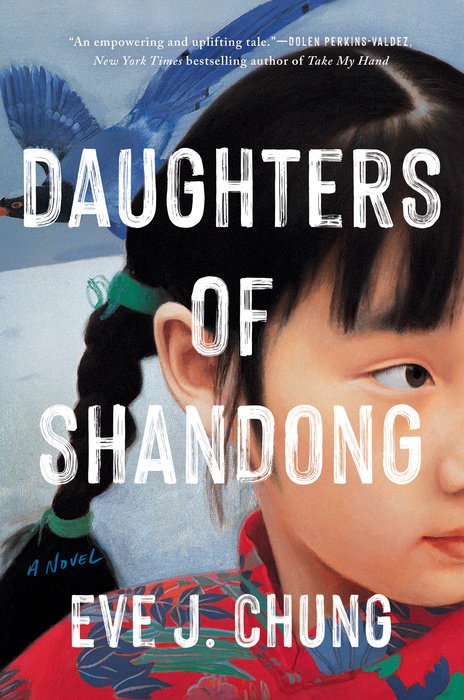 Book you're an evangelist for:
Book you're an evangelist for:
The Little Prince by Antoine de Saint-Exupéry. I didn't like it when I was a child, but loved it as an adult, possibly because it reminds me of the innocence of childhood.
Book you've bought for the cover:
The Apology by Jimin Han. As a child, I loved persimmons, which are on the hardcover version of the book. It turned out to be a great book, about a 105-year-old Korean woman who must correct a mistake that she made to cover up a family secret.
Book you hid from your parents:
I didn't have to hide books from my parents--they were always very supportive of me reading, but English was also their second language so they were unlikely to police my reading when I was at a level that was more advanced than their own.
Book that changed your life:
The Mists of Avalon by Marion Zimmer Bradley. I loved that she took a popular story and spun it from a woman's perspective, and then laced it with magic.
Favorite line from a book:
I have so many, but a recent line that I admired so much that I wrote it down was from Slow Noodles by Chantha Nguon, a memoir about the Cambodian civil war and ensuing genocide: "The murderers among us would have us believe that history is slippery and unknowable. Insisting otherwise is an act of defiance."
Five books you'll never part with:
I have moved so many times in my life and parted with many books, so I'll have to say there aren't really any books that I feel like I MUST keep. Clearing out my shelf gives me an excuse to buy new books, so I'm pretty ruthless about it. Everywhere I go, I also immediately find my local library and find a sense of permanence there. One book that I might hold onto for sentimental value is I Dream of Popo by Livia Blackburne and illustrated by Julia Kuo, which is about missing one's relatives who are far away, and grief after losing one's grandma--it is a very Taiwanese book, with illustrations that reminded me of my relatives.
Book you most want to read again for the first time:
The Djinn Waits a Hundred Years by Shubnum Khan was so beautifully written, and unlike any other story--it is a blend of a ghost story, mystery, and romance. I had gotten an early ARC of it, which I read twice, just to savor the language again (and then I bought the book).
What book did you wish was around when you were a child?
I don't read much MG or YA now, but there are so many books that I wish had been around when I was younger. They were books that I probably needed to see myself in, and would have helped me deal with some of the issues that I faced in middle and high school. Iron Widow by Xiran Jay Zhao is a book that I would have loved to have as a teenager because it combines feminist rage with a fantastic story.
Book Candy
Book Candy
Earsling, for example. Mental Floss shared "20 brilliant Anglo-Saxon words we should bring back."
---
The Public Domain Review featured the first volume of Le Petit Journal des Refusées (The Little Journal of Rejects, 1896).
---
Hear Leo Tolstoy read from his last major work in four languages, 1909." (via Open Culture)
Rediscover
Rediscover: Caleb Carr
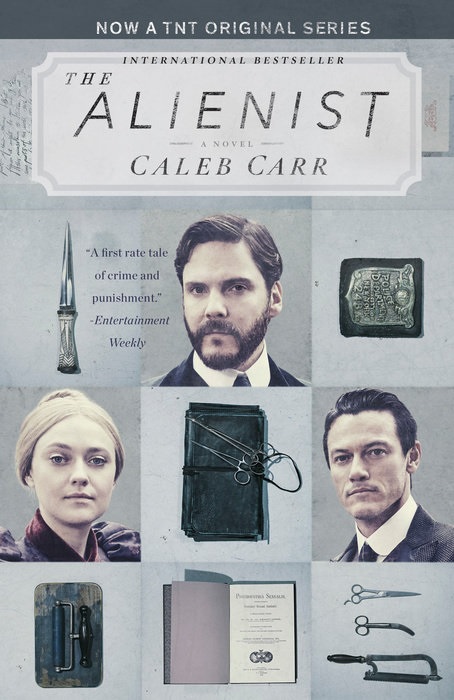 Caleb Carr, a military historian and author "whose experience of childhood abuse drove him to explore the roots of violence--most famously in his 1994 bestseller, The Alienist, a period thriller about the hunt for a serial killer in 19th-century Manhattan," died May 23 at age 68, the New York Times reported.
Caleb Carr, a military historian and author "whose experience of childhood abuse drove him to explore the roots of violence--most famously in his 1994 bestseller, The Alienist, a period thriller about the hunt for a serial killer in 19th-century Manhattan," died May 23 at age 68, the New York Times reported.
Carr was 39 when he published The Alienist, a book he had first pitched as nonfiction. It wasn't, but read that way because of the exhaustive research he had done into the period and the historical figures who featured as characters. The Alienist was an immediate hit and earned glowing reviews. Even before it was published, the movie rights were acquired, though the project never made it to the big screen. In 2018, however, a 10-episode mini-series was released on TNT.
Magazine writers were captivated by Carr's "downtown cool--he lived on the Lower East Side of Manhattan, had been in a local punk band, wore black high-top sneakers and had shoulder-length hair--and by his literary provenance. His father was Lucien Carr, a journalist who was muse to and best friends with Beat royalty: the writers Jack Kerouac, William S. Burroughs and Allen Ginsberg. Beautiful and charismatic as a young man, 'Lou was the glue,' Ginsberg once said, that held the group together," the Times wrote.
Lucien Carr was also an alcoholic, and his son grew up in bohemian chaos, with his father raging at his wife and three sons but directing his most terrifying outbursts at Caleb, his middle child, whom he singled out for physical abuse.
"There's no question that I have a lifelong fascination with violence," Caleb Carr told Stephen Dubner of New York magazine in 1994, just before The Alienist was published. "Part of it was a desire to find violence that was, in the first place, directed toward some purposeful end, and second, governed by a definable ethical code. And I think it's fairly obvious why I would want to do that."
His father had been sexually molested by his Boy Scout master, David Kammerer, who followed Lucien Carr when he entered Columbia University. In 1944, Lucien Carr killed his longtime predator in Riverside Park, stabbing him with his Boy Scout knife and rolling him into the Hudson River. Kerouac helped him dispose of the knife. Carr turned himself in the next day and served two years for manslaughter in a reformatory.
Kerouac and Burroughs wrote about the incident in a novel, And the Hippos Were Boiled in Their Tanks, which was rejected by publishers and then mired in legalities before finally being published in 2008, when all the principals were dead. In 2013, the incident was the subject of a film, Kill Your Darlings, starring Daniel Radcliffe as Ginsberg.
Before The Alienist was published, Caleb Carr had been writing on military subjects, including a book with James Chace about national security and, on his own, a biography of an American soldier of fortune who became a Chinese military hero in the mid-19th century. In 1997, Carr published The Angel of Darkness, a sequel to The Alienist. His other works include The Italian Secretary (2005), Surrender, New York (2016), and Lessons of Terror: A History of Warfare Against Civilians (2002). His last book, published in April, was My Beloved Monster: Masha, the Half-Wild Rescue Cat Who Rescued Me.
"I have a grim outlook on the world, and in particular on humanity," he told Joyce Wadler of the Times in 2005. "I spent years denying it, but I am very misanthropic. And I live alone on a mountain for a reason."
| Advertisement Meet belle bear! |


